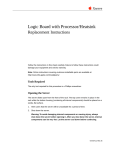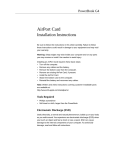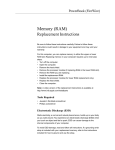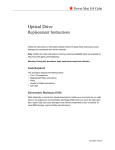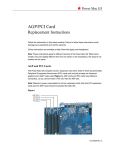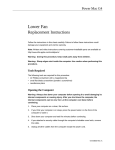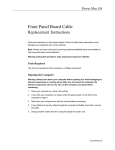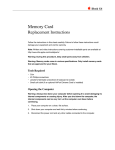Download Apple Hard Drive User's Manual
Transcript
PowerBook G4 Hard Drive Replacement Instructions Follow the instructions in this sheet carefully. Failure to follow these instructions could damage your equipment and void its warranty. Note: Written and video instructions covering customer-installable parts are available at http://www.info.apple.com/installparts/. Warning: Sharp edges can exist inside your computer and on any parts being removed or installed. Use caution to avoid injury. During this procedure, keep small parts away from children. Tools Required • Soft towel or cloth, larger than the PowerBook • Phillips screwdriver, size 1 • Torx T8 screwdriver (provided with hard drive) Backing Up Your Data Warning: Before replacing your hard drive, make sure you back up all data on the drive. Opening the Computer Warning: Always shut down your computer before opening it to avoid damaging its internal components or causing injury. After you shut down the computer, the internal components can be very hot. Let the computer cool down before continuing. To access the hard drive, you must first remove the battery and bottom case. 1. Place your computer on a clean, flat surface. 2. Shut down your computer and wait thirty minutes before continuing. 3. Disconnect the power cord and any other cables connected to the computer. 073-0596 Rev. B 4. Place a towel or soft cloth on a table in front of you. (Figure 1A) The towel or cloth will protect the keyboard and display area of the PowerBook when you flip it over to remove the battery and bottom case. Make sure it covers an area large enough for your PowerBook and that it hangs over the edge of the table. 5. With the display open at an angle greater than 90 degrees, carefully flip the PowerBook over and lay it flat, fully on the table. Make sure the display hangs over the edge of the table and rests lightly on your lap. (Figure 1B) Important: Do not open the display farther than the angle shown. Figure 1 A B 6. Remove the battery by sliding the battery latch to the left. Make sure to return the latch fully to the right. (Figure 2) Removing the battery will prevent you from accidentally turning on the computer. Warning: Removing the battery before shutting down your computer may result in data loss. Figure 2 PowerBook G4 Hard Drive - 2 7. Use a Phillips screwdriver to remove the eight bottom case screws in the order shown. (Figure 3) Important: To avoid damaging the case, be careful that the screwdriver tip does not slip out of the screw head during removal. Figure 3 1 4 3 2 5 8 7 6 Note: In the following two steps you will disengage the left and right sides of the bottom case and then pivot it forward to remove. 8. Carefully slide the bottom case away from you. (Figure 4) Important: Do not push on the rubber feet of the bottom case. Figure 4 PowerBook G4 Hard Drive - 3 9. Pivot the bottom case up as shown. (Figure 5) Figure 5 10. Touch the computer’s inside framework (a dull gray conductive composite material) to discharge any static electricity, as shown. (Figure 6) Important: To avoid electrostatic discharge damage, always ground yourself by touching the computer’s framework before you touch any parts or install any components inside the computer. To avoid static electricity building back up in your body, do not walk around the room until you have completed your installation and closed the computer. Figure 6 PowerBook G4 Hard Drive - 4 Removing the Installed Hard Drive 1. With your fingers, carefully pry up the hard drive flex cable connector (Figure 7A) at its sides to disconnect it from the logic board. You may need to pry one side, then the other, in a rocking motion. Figure 7 A 2. With a Torx T8 screwdriver, remove the two screws (Figure 8) that secure the hard drive to the mounting bracket and then gently remove the hard drive. Important: Do not pull on the flex cable or use the cable as a handle. Figure 8 Note: There are four rubber stoppers on the hard drive that fit over screws (two on each side). Remove any that may have fallen off or that remain in the holes in the mounting bracket inside the computer. 3. If not included with the replacement drive, remove the Mylar sheath and the flex cable to transfer to the replacement drive. Important: The connector pins on the hard drive are fragile and bend easily. Use care to keep the pins straight when removing or installing the flex cable. PowerBook G4 Hard Drive - 5 Installing the Replacement Hard Drive Warning: To avoid potential injury, avoid touching or brushing against the thin strip of metal that extends up from the hard drive mounting bracket (Figure 9A). Important: Avoid touching the optical drive as you perform this procedure. 1. With a Torx T8 screwdriver, remove the screw from the top of the hard drive mounting bracket. (Figure 9B) 2. Carefully lift the mounting bracket up (Figure 9C) and gently bend it around the first battery bay tab (Figure 9D). The tab holds the bracket out of the way. Warning: Lift the bracket just high enough to clear the battery bay tab. If you lift the bracket higher than the tab you risk damaging the bracket, and such damage is not covered by the limited warranty on your computer. Figure 9 B D C A PowerBook G4 Hard Drive - 6 3. Make sure that the screws (Figure 10A) and rubber stoppers (Figure 10B) are in place on the sides of the replacement drive. 4. Install the Mylar sheath (Figure 10C) so that it covers the bottom and left and right sides of the drive. The sheath is directional and must be installed in the direction that does not extend beyond the front of the drive. 5. Carefully install the flex cable to the hard drive, if needed, (Figure 10D). The connector is keyed to fit only one way. Figure 10 B C D A 6. Insert the right side of the drive first, until the rubber stoppers fit securely into the holes in the bracket, and then insert the left side of the drive. (Figure 11) Note: Make sure that the rubber stoppers do not fall off during installation. Important: Make sure that the flex cable does not get pinched behind the drive during installation. Figure 11 PowerBook G4 Hard Drive - 7 7. Lift the mounting bracket (Figure 12A) over the battery bay tab and lower it to its original position. Line up the rubber stoppers on the hard drive until they fully seat into the holes in the bracket. Note: To help with alignment, the Torx T8 screwdriver can be inserted into the screws on the hard drive through the holes in the mounting bracket. Important: Verify that the bottom of the mounting bracket clears and seats behind a thin metal ridge located along the bottom of the battery compartment. (Figure 12B) 8. Replace the screw (Figure 12C) in the top of the mounting bracket, being careful not to overtighten it. Figure 12 C A B 9. Connect the hard drive’s flex cable connector (Figure 13) to the logic board. Figure 13 PowerBook G4 Hard Drive - 8 Closing the Computer 1. To attach the bottom case, align the notches on the right and left sides of the case, then press down slightly to secure the case. Check the alignment of the eight screw holes to make sure the bottom case is properly positioned. Important: Make sure that the seams between the bottom case and the frame are closed. Check the outside edges and around the battery well. Verify that the alignment tab on the underside of the bottom case (Figure 14A) has seated, and the case lies flat. 2. Replace the eight screws in the order shown. (Figure 14) Note: The screws must go in straight and easily; if they do not, readjust the bottom case for proper alignment. Do not overtighten the screws or damage could result. Important: To avoid damaging the case, be careful that the screwdriver tip does not slip out of the screw head during tightening. Figure 14 8 5 6 A 7 2 4 1 3 PowerBook G4 Hard Drive - 9 3. Replace the battery. (Figure 15) Important: Make sure that the battery locks securely into place and that the battery latch is slid all the way into the locked position. Figure 15 4. Turn the computer over. Look at the optical drive slot to make sure that the case is properly secured. If a gap exists below the slot, gently pull the bottom of the optical drive slot toward you until it clicks into place and the gap is removed. (Figure 16) Figure 16 ® PowerBook G4 Hard Drive - 10 5. Reconnect the power cord and any other cables that were connected, and restart your computer. Warning: Never turn on your computer unless all of its internal and external parts are in place and it is closed. Operating the computer when it is open or missing parts can damage your computer or cause injury. 6. Restore the data from your backup to the new drive. 7. Check the operation of the optical drive. If the hard drive is installed incorrectly, the optical drive mechanism might not spin correctly and will result in mechanical noise when playing a disc. Apple Computer, Inc. © 2002 Apple Computer, Inc. All rights reserved. This document is protected under U.S. Copyright Law and International Treaties, and no part of this document may be reproduced in any form without written permission from Apple. Apple is not responsible for typographical, printing, or inadvertent errors. Apple Computer, Inc. 1 Infinite Loop Cupertino, CA 95014-2084 USA + 1 408 996 1010 http://www.apple.com Apple, the Apple logo, and PowerBook are trademarks of Apple Computer, Inc., registered in the U.S. and other countries. PowerBook G4 Hard Drive - 11











